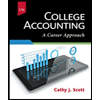
Journal: A journal is the complete record of a financial transaction which shows the debit and credit of respective accounts for every transaction including the explanation of the transaction.
T-Accounts: An account is a unique record of increases or decreases in any asset, liability, equity, revenues or expenses. T-accounts are drawn to resemble a T-shape with debit on the left and credit on the right. Assets and expenses have normally debit balances and liability, equity and revenue accounts have normally credit balance.
To analyze:
The given transaction using accounting equation.
Journal: A journal is the complete record of a financial transaction which shows the debit and credit of respective accounts for every transaction including the explanation of the transaction.
T-Accounts: An account is a unique record of increases or decreases in any asset, liability, equity, revenues or expenses. T-accounts are drawn to resemble a T-shape with debit on the left and credit on the right. Assets and expenses have normally debit balances and liability, equity and revenue accounts have normally credit balance.
To prepare:
Journal Entries for the given transaction.
Accounting Equation: Accounting equation is also known as balance sheet equation. Accounting equation is based on the principles of double entry system of accounting. The accounting equation is as follows
Journal: A journal is the complete record of a financial transaction which shows the debit and credit of respective accounts for every transaction including the explanation of the transaction.
T-Accounts: An account is a unique record of increases or decreases in any asset, liability, equity, revenues or expenses. T-accounts are drawn to resemble a T-shape with debit on the left and credit on the right. Assets and expenses have normally debit balances and liability, equity and revenue accounts have normally credit balance.
To prepare:
T-accounts for the given transactions.
Want to see the full answer?
Check out a sample textbook solution
Chapter D Solutions
Managerial Accounting
- Xavier Manufacturing has a contribution margin ratio of 25%. The company's break-even point is 120,000 units, and the selling price of its only product is $4.80 per unit. What are the company's fixed expenses?arrow_forwardI need help finding the accurate solution to this general accounting problem with valid methods.arrow_forwardSolve with explanation and accountingarrow_forward
- subject = general accountingarrow_forwardBenevolent Professor Martin Company has an overhead cost pool for inspecting. The expected overhead cost is $420,000, and the estimated number of inspections is 15,000. The activity-based overhead rate (ABOR) used to assign the costs of the inspecting cost pool to products is __.arrow_forwardCan you explain this general accounting question using accurate calculation methods?arrow_forward
- Can you explain this general accounting question using accurate calculation methods?arrow_forwardI am looking for a reliable way to solve this financial accounting problem using accurate principles.arrow_forwardKendra had a gross weekly paycheck of $915 last week. Kendra worked 6 hours for 4 of the days and 8 hours on 1 day. What is Kendra’s hourly rate of pay?arrow_forward
 Individual Income TaxesAccountingISBN:9780357109731Author:HoffmanPublisher:CENGAGE LEARNING - CONSIGNMENT
Individual Income TaxesAccountingISBN:9780357109731Author:HoffmanPublisher:CENGAGE LEARNING - CONSIGNMENT Intermediate Accounting: Reporting And AnalysisAccountingISBN:9781337788281Author:James M. Wahlen, Jefferson P. Jones, Donald PagachPublisher:Cengage LearningPrinciples of Accounting Volume 1AccountingISBN:9781947172685Author:OpenStaxPublisher:OpenStax College
Intermediate Accounting: Reporting And AnalysisAccountingISBN:9781337788281Author:James M. Wahlen, Jefferson P. Jones, Donald PagachPublisher:Cengage LearningPrinciples of Accounting Volume 1AccountingISBN:9781947172685Author:OpenStaxPublisher:OpenStax College College Accounting (Book Only): A Career ApproachAccountingISBN:9781337280570Author:Scott, Cathy J.Publisher:South-Western College Pub
College Accounting (Book Only): A Career ApproachAccountingISBN:9781337280570Author:Scott, Cathy J.Publisher:South-Western College Pub





